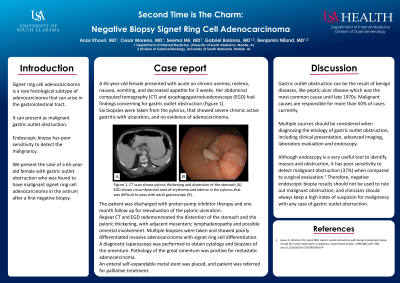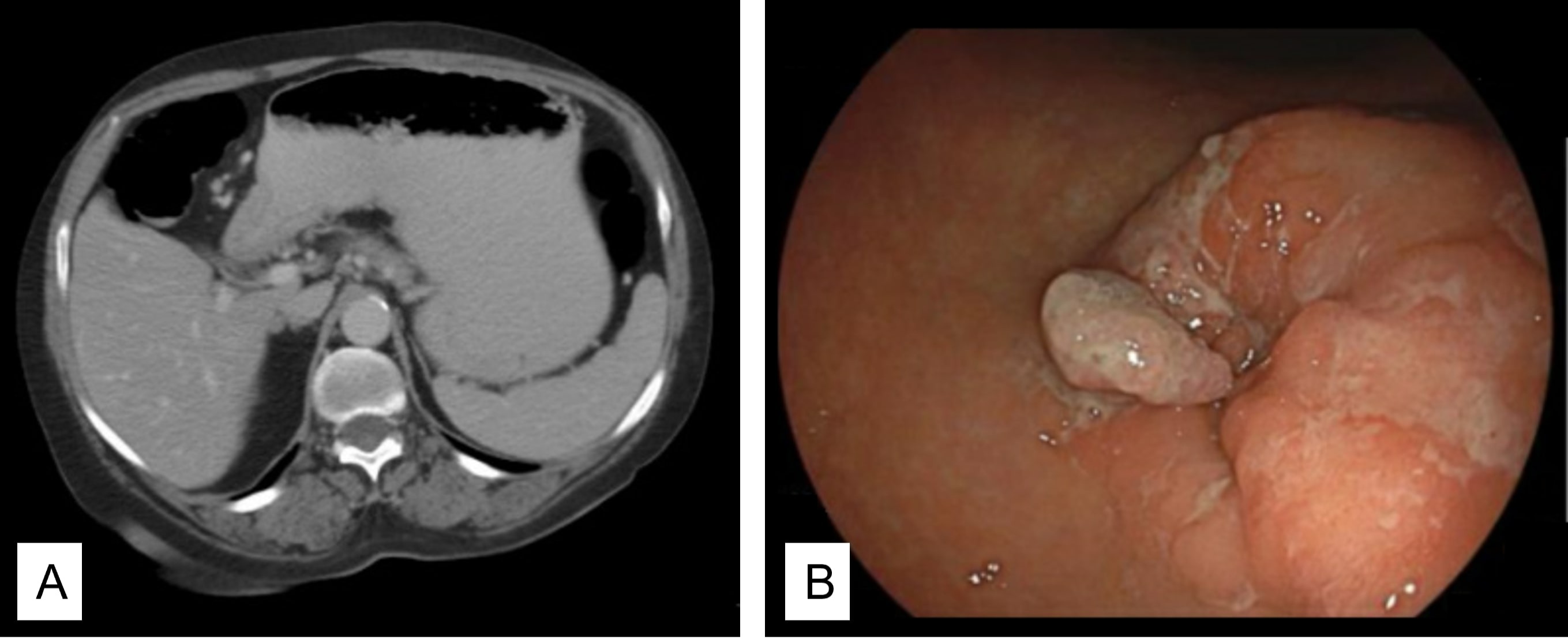Back


Poster Session B - Monday Morning
Category: Stomach
B0719 - Second Time Is the Charm: Negative Biopsy Signet Ring Cell Adenocarcinoma
Monday, October 24, 2022
10:00 AM – 12:00 PM ET
Location: Crown Ballroom

Has Audio

Anas Khouri, MD
University of South Alabama
Mobile, AL
Presenting Author(s)
Anas Khouri, MD, Cesar Moreno, MD, Seema Mir, MD, Gabriel A. Bolanos Guzamn, MD, Benjamin Niland, MD
University of South Alabama, Mobile, AL
Introduction: Signet ring cell adenocarcinoma is a rare histological subtype of adenocarcinoma that can arise in the gastrointestinal tract. It can present as malignant gastric outlet obstruction. Endoscopic biopsy has poor sensitivity to detect the malignancy. We present the case of a 65-year-old female with gastric outlet obstruction who was found to have malignant signet ring cell adenocarcinoma in the antrum after a first negative biopsy.
Case Description/Methods: A 65-year-old female presented with acute on chronic anemia, melena, nausea, vomiting, and decreased appetite for 3 weeks. Her abdominal computed tomography (CT) and esophagogastroduodenoscopy (EGD) had findings concerning for gastric outlet obstruction (Figure 1). Six biopsies were taken from the pylorus, that showed severe chronic active gastritis with ulceration, and no evidence of adenocarcinoma.
The patient was discharged with proton pump inhibitor therapy and one month follow up for reevaluation of the pyloric ulceration.
Repeat CT and EGD redemonstrated the distention of the stomach and the pyloric thickening, with adjacent mesenteric lymphadenopathy and possible omental involvement. Multiple biopsies were taken and showed poorly differentiated invasive adenocarcinoma with signet ring cell differentiation.
A diagnostic laparoscopy was performed to obtain cytology and biopsies of the omentum. Pathology of the great omentum was positive for metastatic adenocarcinoma (stage IV). Patient was treated with enteral self-expandable metal stent and referral for palliative treatment.
Discussion: Gastric outlet obstruction can be the result of benign diseases, like peptic ulcer disease which was the most common cause until late 1970s, or malignant causes which are responsible for more than 50% of cases currently.
Multiple sources should be considered when diagnosing the etiology of gastric outlet obstruction, including clinical presentation, advanced imaging, laboratory evaluation and endoscopy.
Although endoscopy is a very useful tool to identify masses and obstruction, it has poor sensitivity to detect malignant obstruction (only 37%) when compared to surgical evaluation. Therefore, negative endoscopic biopsy results should not be used to rule out malignant obstruction, and clinicians should always keep a high index of suspicion for malignancy with any case of gastric outlet obstruction.

Disclosures:
Anas Khouri, MD, Cesar Moreno, MD, Seema Mir, MD, Gabriel A. Bolanos Guzamn, MD, Benjamin Niland, MD. B0719 - Second Time Is the Charm: Negative Biopsy Signet Ring Cell Adenocarcinoma, ACG 2022 Annual Scientific Meeting Abstracts. Charlotte, NC: American College of Gastroenterology.
University of South Alabama, Mobile, AL
Introduction: Signet ring cell adenocarcinoma is a rare histological subtype of adenocarcinoma that can arise in the gastrointestinal tract. It can present as malignant gastric outlet obstruction. Endoscopic biopsy has poor sensitivity to detect the malignancy. We present the case of a 65-year-old female with gastric outlet obstruction who was found to have malignant signet ring cell adenocarcinoma in the antrum after a first negative biopsy.
Case Description/Methods: A 65-year-old female presented with acute on chronic anemia, melena, nausea, vomiting, and decreased appetite for 3 weeks. Her abdominal computed tomography (CT) and esophagogastroduodenoscopy (EGD) had findings concerning for gastric outlet obstruction (Figure 1). Six biopsies were taken from the pylorus, that showed severe chronic active gastritis with ulceration, and no evidence of adenocarcinoma.
The patient was discharged with proton pump inhibitor therapy and one month follow up for reevaluation of the pyloric ulceration.
Repeat CT and EGD redemonstrated the distention of the stomach and the pyloric thickening, with adjacent mesenteric lymphadenopathy and possible omental involvement. Multiple biopsies were taken and showed poorly differentiated invasive adenocarcinoma with signet ring cell differentiation.
A diagnostic laparoscopy was performed to obtain cytology and biopsies of the omentum. Pathology of the great omentum was positive for metastatic adenocarcinoma (stage IV). Patient was treated with enteral self-expandable metal stent and referral for palliative treatment.
Discussion: Gastric outlet obstruction can be the result of benign diseases, like peptic ulcer disease which was the most common cause until late 1970s, or malignant causes which are responsible for more than 50% of cases currently.
Multiple sources should be considered when diagnosing the etiology of gastric outlet obstruction, including clinical presentation, advanced imaging, laboratory evaluation and endoscopy.
Although endoscopy is a very useful tool to identify masses and obstruction, it has poor sensitivity to detect malignant obstruction (only 37%) when compared to surgical evaluation. Therefore, negative endoscopic biopsy results should not be used to rule out malignant obstruction, and clinicians should always keep a high index of suspicion for malignancy with any case of gastric outlet obstruction.

Figure: Figure 1. CT scan 1/2022 shows pyloric thickening and distention of the stomach (A). EGD shows circumferential area of erythema and edema in the pylorus that was difficult to pass with adult gastroscope (B).
Disclosures:
Anas Khouri indicated no relevant financial relationships.
Cesar Moreno indicated no relevant financial relationships.
Seema Mir indicated no relevant financial relationships.
Gabriel Bolanos Guzamn indicated no relevant financial relationships.
Benjamin Niland indicated no relevant financial relationships.
Anas Khouri, MD, Cesar Moreno, MD, Seema Mir, MD, Gabriel A. Bolanos Guzamn, MD, Benjamin Niland, MD. B0719 - Second Time Is the Charm: Negative Biopsy Signet Ring Cell Adenocarcinoma, ACG 2022 Annual Scientific Meeting Abstracts. Charlotte, NC: American College of Gastroenterology.
